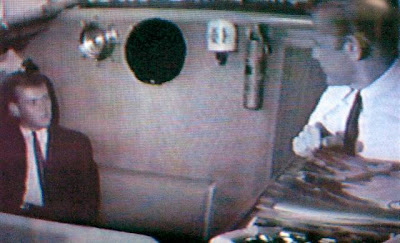

The Seminal 1963
Two Extraordinary Teleplays in a Year
of Unbridled Social Change

Who Do You Kill?
Airing as an episode of "East Side, West Side"
on November 4, 1963 via CBS
by Arnold Perl; directed by Tom Gries
Willard Levitas, associate producer; photographed under the direction of Jack Priestley; Arthur Singer, story editor; original music composed by Kenyon Hopkins; music produced by R. A. Israel; Joan Chaffee, film editor; art direction by Sy Tomashoff; costumes by Gene Coffin
The Cast: [regulars] George C. Scott as Neil Brock; Elizabeth Wilson as Frieda Hechlinger; Cicely Tyson as Jane Foster; [guest] James Earl Jones as Joe Goodwin; Diana Sands as Ruth (Mrs. Joe) Goodwin; Maxwell Glanville as The Reverend Mr. Williams; Godfrey Cambridge as Portly; P. Jay Sidney as Dr. Frazer; George Gaynes as Mr. Stowe; John McCurry as Morgan; Douglas Turner Ward as Feller; Doris Belack as a Nurse; Dan Morgan as another Doctor; Cynthia Belgrave as a Neighbor; Stephen Pearlman as another Neighbor; Carla Pinza as Mrs. Martinez; Joseph Sullivan as Stowe; Earl Sydnor as the Undertaker
This explosive teleplay, trenchantly written by Arnold Perl and directed with great poignance by Tom Gries, showcases the talents of both James Earl Jones and Diana Sands as the African-American couple Joe and Ruth Goodwin, coping with their son's ultimately fatal bite by an infected rat. Producer David Susskind's series, the most acclaimed of 1963, was set in the milieu of a Manhattan private welfare agency, with George C. Scott as the intrepid social worker Neil Brock; live drama veteran Elizabeth Wilson as supervisor Frieda Hechlinger, and Cicely Tyson as the equally conscientious secretary Jane Foster.
The teleplay would be the great thespian Jones' first truly significant outing on American national television. From his earliest rages against the squalid conditions unaddressed (this in the ongoing Susskind parable that graphically but unpretentiously raised a sword to the urban indifference), through his throbbing desolation at his son's funeral, Jones would become justifiably an overnight sensation. In scene-for-scene his rages and then his unvitiated sense of loss is met perfectly by the too-soon-gone (dead at all of 39 on September 21, 1973) Ms. Sands, also at the apex of her acting prowess.
Still, "Who Do You Kill?," the title encapsulating Joe Goodwin's expression of outrage at an enemy undefined and perhaps even undefinable, is clearly a James Earl Jones tour-de-force. After this television performance, Jones would never look back, becoming one of theatre, cinema and television's truly gifted actors. Indeed, in a great diversity of characterizations over the next five decades, ranging from Shakespeare to Pulitzer Prize-winning playwright August Wilson's many-faceted delineations of the black experience, Mr. Jones would become a legend in his own time.

The great James Earl Jones as Joe Goodwin, grieves at the funeral of his young son in the climactic scene of Arnold Perl's wrenchingly poignant "Who Do You Kill?," an episode of CBS' "East Side, West Side," airing November 4, 1963. After this tour-de-force performance, Mr. Jones would never look back, becoming one of the nation's most gifted and indeed legendary, actors.

I'm Here to Kill a King
Airing as an episode of "Route 66" via CBS
scheduled to air on November 29, 1963, but not seen until the following summer, postponed as a result of its highly controversial content, concerning a planned political assassination by a sociopath, in the aftermath of the real-life assassination of President John Fitzgerald Kennedy just one week earlier.
by Stirling Silliphant; directed by Allen Reisner
Herbert B. Leonard, executive producer; Leo Davis, producer; original music by Nelson Riddle; photographed under the direction of Irving Lippman; Aaron Nipley and Jack Gleason, film editors; art direction by John J. McCormack; costumes designed by Edward L. Lossmann
The Cast: [regulars] Martin Milner as Tod Stiles; Glenn Corbett as Linc Case; [guest] Robert Loggia as Colonel Zaman; Tina Louise as Robin; Arnold Moss as The King; Frank Campanella as Mr. Pierson; Jack Dabdoub as Kahwaji
The recent release on home video (currently only seasons one and two), following the re-telecast via Nick at Nite a decade earlier of the CBS series "Route 66" has provided yet another generation with a fresh look at one of the most splendid of series highly representative of early 1960s ambiance. Creator Stiriling Silliphant wrote frequently for the series, showcasing his abundant skill for dramaturgy most effectively in this chilling tale of accomplished and aborted political assassination. The year before had seen the premiere of John Frankenheimer's acclaimed cinematic rendition of Richard Condon's macabre novel "The Manchurian Candidate," withdrawn and long absent from cinema houses following the real-life assassination of President John Fitzgerald Kennedy. How much the more unusual, then, that Silliphant's teleplay was actually scheduled to air just one week following that most heavily reported of any assassination in modern memory. So pungent were the political implications of Silliphant's script that the episode could not be telecast for some time.
Briefly stated, while with his then traveling companion Lin Case (Glenn Corbett), Tod Stiles (Martin Milner), now in Niagara Falls, has been accidentally slipped an envelope containing an itinerary whose events parallel those of a visiting Arab king, whose petroleum interests have brought him to the Falls. What is not then known to Tod is the fact that he closely resembles, to the point that he could pass for his twin, the would-be assassin of the Arab king. In the complicated series of events which follow, Tod is mistaken for the would-be assassin Paul Kades (Milner in a dual role), not merely by the courier who has slipped him the Kades itinerary, but by Linc Case as well. The mercenary Kades has been paid by Colonel Zaman (Robert Loggia in an early maleficent role), the King's right arm, and from whom Zaman intends usurpation. Forewarned of a possible assassin at the Falls, before disembarking from the plane, the King (Arnold Moss) comments: 'When one sits atop the sands that sit atop an ocean of oil, you'd better know the difference between sand and oil." Nevertheless, the King suspects Zaman, and unbeknownst to American Secret Service agents, forces Zaman, of similar height and build, to don the King's regalia, while the King assumes the role of Colonel. Thus it comes to pass that Kades kills the Colonel, and yet another assassin, in the employ of the Colonel to dispose of Kades in turn, guns down Kades.
Brimming with trenchant dialogue, perhaps the best of Silliphant's long Hollywood career, the teleplay tingles with excitement, particularly as one witnesses the numerous Kennedy assassination parallels. At one point the King actually refers to Dallas, Texas as a favorite place in which to furtively discuss petroleum deals. His disembarkation from the plane is greeted with an eerily similar display of flashbulbs of local, national and international paparazzi. Milner, one of the most underrated of Hollywood actors, has a field day with his Kades character who greets his look-alike Tod with "one for the books, huh, kid? Why not? They finally ran out of patterns and yours is one of the better ones!" Tod, the always fascinated captive, responds to this methodical killer "Who are you? Every nightmare I ever dreamed? Every filthy thought? Every lousy impulse? Are you the discards of me, the other side of me?" Kades, unrelenting, cannot however bring himself to kill his physical likeness; to the cadence of Niagara church bells playing "Rock of Ages," which he calls the "music to take a trip by," he finds his hand unable to pull the trigger that would terminate the manacled Tod before him. It is this singular cry from an otherwise vacant conscience which is Kades' own undoing. "Uneasy is the head that wears a crown," Tod observes early on. And uneasy is the viewer of "I'm Here to Kill a King," well over four decades after political assassination came into our living rooms.

Above: The underrated Martin Milner in a dual role as the sociopathic assassin Paul Kades, at right, who has manacled the despairing but always fascinated Tod Stiles, in the justifiably long postponed "I'm Here to Kill a King." "Uneasy is the head that wears a crown," Tod observes early on. This was easily the prolific Stirling Silliphants's most sterling effort on behalf of his still admired CBS enterprise "Route 66."












No comments:
Post a Comment